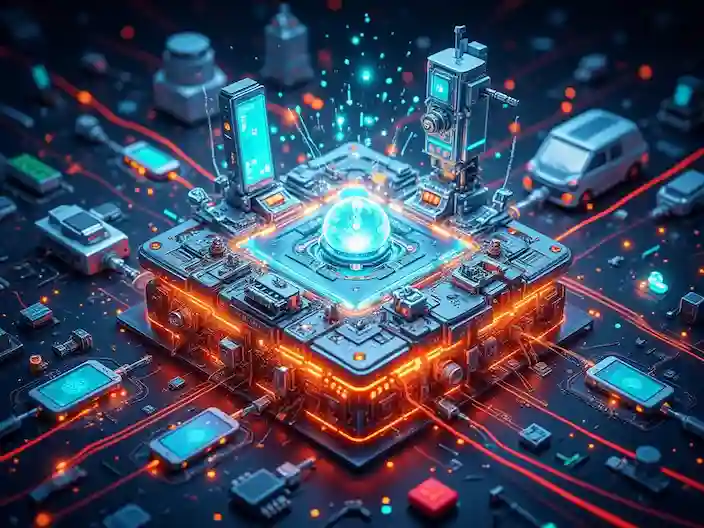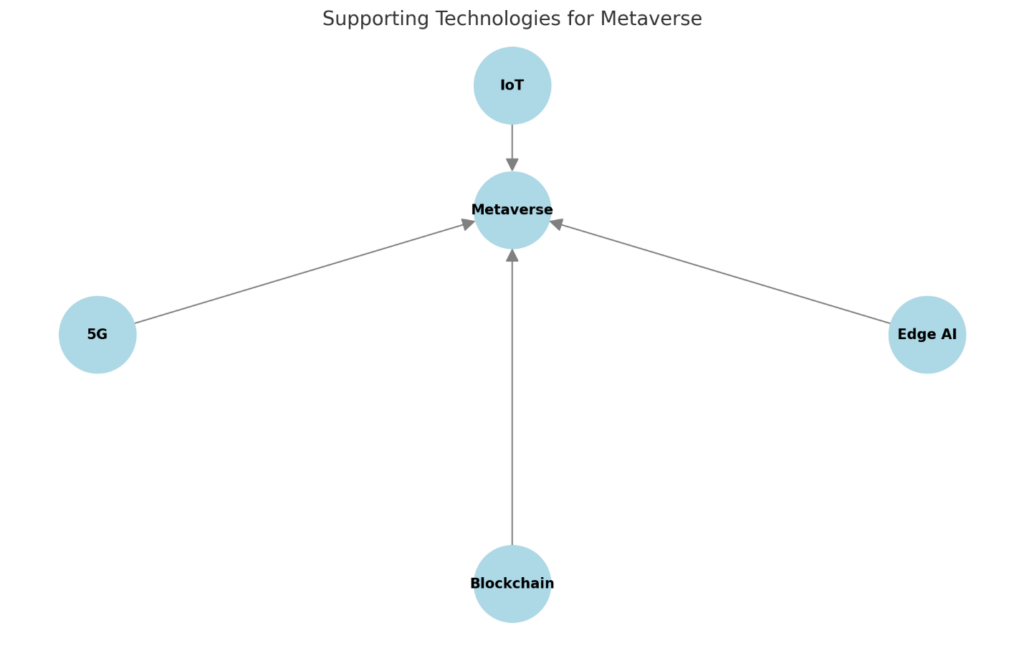Table of Contents
- Introduction
- Applications of Edge Computing in the Metaverse
- Reducing Latency in Real-Time Interactions
- Personalizing User Experience
- Enhancing Real-Time Graphics and Rendering
- Low-Cost and High-Speed Communications with 5G and IoT Technologies
- Supporting the Metaverse Economy and Digital Transactions
- Improving Social Experience in the Metaverse
- Applications in Healthcare and Treatment Environments
- Supporting Technologies
- 5G Networks
- Internet of Things (IoT)
- Edge AI (Artificial Intelligence)
- Blockchain in the Metaverse
- References
Introduction
In today’s rapidly expanding virtual and digital world, the metaverse has become a transformative and interactive space with features such as Virtual Reality (VR), Augmented Reality (AR), and the Internet of Things (IoT). This innovative environment is gaining prominence in reshaping human communication. It offers potential applications in gaming, education, commerce, and healthcare. However, despite its vast potential, the realization of this technology faces multiple technical challenges, the most significant being the latency in data processing and real-time interactions.
In this context, Edge Computing emerges as an innovative solution to address these challenges. By processing data closer to the source, Edge Computing can significantly reduce network latency, enabling real-time and instantaneous experiences in the metaverse. This paper examines the applications of Edge Computing in enhancing the speed and accuracy of real-time interactions in the metaverse, analyzing its impact on reducing latency, improving network efficiency, and personalizing user experiences.
The paper also explores supporting technologies such as 5G networks, IoT, Edge AI, and Blockchain, which strengthen the metaverse infrastructure. Finally, it discusses the challenges and emerging opportunities these technologies present in the metaverse industry and offers innovative solutions for its future development.

Applications of Edge Computing in the Metaverse
Edge Computing is a key technology that significantly enhances the capabilities of the metaverse by reducing latency, increasing processing speed, and improving real-time interactions. This technology can improve the performance of the metaverse across a wide range of applications. Below are the primary applications of Edge Computing in the metaverse:
- Reducing Latency in Real-Time Interactions
One of the biggest challenges in the metaverse is the need for real-time responsiveness. Users expect interactions in the virtual environment to be as fast and accurate as those in the real world. Edge Computing reduces latency by processing data near its source.
- Example in Multiplayer VR Games:
In these games, a player’s movement must be instantly reflected to other users. Using Edge Computing, players’ movement data is processed quickly at the nearest server and immediately transmitted to other users.
- Statistical Analysis:
Research has shown that the use of Edge Computing can reduce latency in metaverse environments by up to 50%, significantly enhancing the user experience .
- Personalizing User Experience
Edge Computing enables local processing of user data, leading to personalized experiences.
- User Behavior Analysis: Using Edge AI, real-time analysis of user behavior, preferences, and interactions is conducted.
- Example in Educational Metaverse: In a virtual classroom, Edge Computing can instantly adapt educational content based on each student’s progress and needs.
- Data Security: Since data is processed at the edge, the risk of exposing users’ personal information is reduced, ensuring better privacy protection.
- Enhancing Real-Time Graphics and Rendering
In the metaverse, complex graphical environments require real-time rendering. This process, which typically demands high processing power, is accelerated with Edge Computing.
- Example in Industrial Simulations: In design and industrial simulations, 3D models are rendered rapidly using Edge Computing and made available to users.
- Augmented Reality (AR): In AR applications, real-world environment data is quickly processed and combined with virtual content, providing a seamless and realistic experience .
- Low-Cost and High-Speed Communications with 5G and IoT
Edge Computing, in combination with 5G and IoT technologies, enables fast, high-bandwidth communications.
- Example in Smart Metaverse Homes: IoT-connected smart devices quickly process environmental data and transfer it to the metaverse. This allows users to synchronize virtual environments with their real-world surroundings.
- Bandwidth Enhancement: The use of 5G alongside Edge Computing speeds up data transfer and reduces network congestion .

- Supporting the Metaverse Economy and Digital Transactions
Edge Computing provides the infrastructure for managing real-time transactions in the metaverse economy.
- Use in NFT Markets: Users can trade their digital assets in real time, while transaction data is processed and recorded at the edge using Blockchain.
- Micropayments: Edge Computing facilitates fast micropayments with low fees, which are essential for buying and selling virtual goods and services .
- Improving Social Experience in the Metaverse
Edge Computing can enhance social interactions in the metaverse.
- Virtual Conferences and Events: In environments like virtual conferences, audio and video data from users are quickly processed, and their interactions are displayed in real-time.
- Metaverse Social Networks: In 3D social networks, Edge Computing optimizes user interactions, including messages and interactive activities .
- Applications in Healthcare and Treatment Environments
In healthcare, Edge Computing can enhance VR and AR-based treatments.
- Example in Rehabilitation: Using Edge Computing, patients’ movement data is processed in real-time, providing feedback during rehabilitation.
- Remote Diagnosis: Doctors can monitor patients’ conditions in real-time in the metaverse and provide suitable treatments.
Supporting Technologies
Edge Computing alone cannot address all the needs of the metaverse. To fully realize the potential of this technology, it must be integrated with other advanced technologies. In this section, key supporting technologies that act as the backbone of the metaverse and Edge Computing are discussed in detail.
- 5G Networks and IoT
5G networks and the Internet of Things (IoT) are critical communication infrastructures that play a vital role in the development of the metaverse.
5G is the next generation of wireless communication that supports the needs of the metaverse and Edge Computing by providing high bandwidth, low latency, and network stability.
- Speed and Low Latency: With latency reduced to less than 1 millisecond, 5G enables real-time interactions in virtual environments. This feature is crucial for multiplayer games and industrial simulations.
- High Capacity: 5G can manage millions of connected devices simultaneously, which is essential for the complex metaverse environment with numerous users and devices.
- Use in Metaverse: In smart metaverse homes, 5G processes sensor data and sends it to the virtual environment at high speed .
- Internet of Things (IoT)
IoT plays a key role in collecting real-world data and transmitting it to the metaverse.
- Physical and Digital Connectivity: IoT enables communication between physical devices and the virtual space, allowing users to control virtual environments with real-world devices.
- Applications in the Metaverse
- Smart Transport: Traffic data collected by IoT sensors can help create accurate road simulations in the metaverse.
- Healthcare and Treatment: IoT wearable devices send real-time health data to the metaverse.

- Edge AI (Edge Artificial Intelligence)
Edge AI combines AI with Edge Computing, enabling complex data processing near the source.
- Real-Time Data Analysis
Edge AI optimizes interactions in the metaverse by analyzing data in real-time.
- Personalizing User Experience: Machine learning algorithms analyze user data locally and deliver content and experiences tailored to their preferences.
- Advanced Image Processing: In AR and VR environments, Edge AI helps identify objects and process images quickly.
- Security and Privacy
Edge AI processes data locally, reducing the risk of transferring sensitive information to central servers, thereby ensuring better security and privacy for users.
Threat Detection: Edge AI can detect unusual activities and prevent cyber-attacks.
- Applications in the Metaverse
- Education: Edge AI analyzes student behavior and adjusts educational content in real time.
- Entertainment: In metaverse games, Edge AI designs NPC behaviors to make them more natural and synchronized with the environment.
- Blockchain in the Metaverse
Blockchain is an essential technology in the metaverse, ensuring transparency, security, and digital ownership.
- Digital Asset Ownership
Blockchain enables secure ownership of digital assets like NFTs.
- NFTs: Users can buy and sell digital assets, such as artwork or in-game items, which are certified with immutable ownership via blockchain.
- Applications in the Metaverse: In virtual marketplaces, users can trade digital land, in-game items, or other virtual goods.
- Secure and Transparent Transactions
Blockchain facilitates fast and transparent transactions in the metaverse.
- Micropayments: Users can buy virtual goods with low transaction fees.
- Contract Management: Smart contracts enable users to manage transactions automatically without intermediaries.
3. Data Security
Blockchain encrypts user data and protects against cyberattacks. This feature is crucial for maintaining user trust in the metaverse [2†source].
- Cloud Rendering and Integration with Edge
ComputingReal-time rendering in the metaverse is one of the major challenges that requires the combination of cloud and edge computing.
- Cloud Rendering: Heavy rendering tasks are performed on cloud servers, and the data is transmitted to user devices.
- Edge Rendering: Edge computing handles local processing tasks to reduce latency and improve the user experience.

This diagram illustrates the relationship between the supporting technologies of the metaverse:
- 5G: For high-speed connectivity and reducing latency.
- IoT: For communication between physical devices and the digital environment.
- Edge AI: For real-time processing and decision-making at the network edge.
- Blockchain: For security, transparency, and digital ownership.
All of these technologies together form the infrastructure of the metaverse, creating an interactive and efficient experience.
References
- Patra, A., Pandey, A., Hassija, V., Chamola, V., & Mishra, R. P. (2024). A Survey on Edge Enabled Metaverse: Applications, Technological Innovations, and Prospective Trajectories. IEEE Access. DOI: 10.1109/ACCESS.2024.3452184
- Hatami, M., Qu, Q., Chen, Y., Kholidy, H., Blasch, E., & Ardiles-Cruz, E. (2024). A Survey of the Real-Time Metaverse: Challenges and Opportunities. Future Internet. DOI: 10.3390/fi16100379
Table of Contents
Toggle


One Response